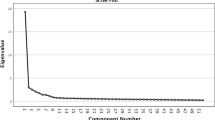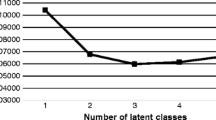Abstract
A substantial proportion of the classroom time involves exposing students to a variety of assessment tasks. As students process these tasks, they develop beliefs about the importance, utility, value, and difficulty of the tasks. This study aimed at deriving a model describing the multivariate relationship between students’ perceptions of the assessment tasks and classroom assessment environment as a function of gender. Using a clustering sampling procedure, participants were 411 students selected from the second cycle of the basic education grades at Muscat public schools in Oman. As defined by McMillan (Educational research: Fundamentals of the consumer, 2012, pp. 176–177), the research design employed in this study was descriptive in nature that includes correlational and comparative aspects. Results revealed statistically significant gender differences with respect to the perceptions of the assessment tasks and classroom assessment environment favoring female students. Also, results showed that for both males and females, a learning-oriented assessment environment tended to be associated with high degrees of congruence with instruction, authenticity, student consultation, and diversity. However, the relationship between performance-oriented assessment environment and perceptions of the assessment tasks differed in male and female classrooms. Implications for instruction and assessment as well as recommendations for future research were discussed.
Similar content being viewed by others
References
Alkharusi, H. (2008). Effects of classroom assessment practices on student’s achievement goals. Educational Assessment, 13, 243–266.
Alkharusi, H. (2009). Classroom assessment environment, self-efficacy, and mastery goal orientation: A causal model. INTI Journal, Special issue on teaching and learning, 104–116.
Alkharusi, H. (2010). Literature review on achievement goals and classroom goal structure: Implications for future research. Electronic Journal of Research in Educational Psychology, 8, 1363–1386.
Alkharusi, H. (2011). Development and datametric properties of a scale measuring students’ perceptions of the classroom assessment environment. International Journal of Instruction, 4, 105–120.
Alkharusi, H. (2013). Canonical correlational models of students’ perceptions of assessment tasks, motivational orientations and learning strategies. International Journal of Instruction, 6, 21–38.
Ames, C. (1992). Achievement goals and the classroom motivational climate. In D. H. Schunk & J. Meece (Eds.), Student perceptions in the classroom (pp. 327–348). Hillsdale, NJ: Erlbaum.
Anderman, E. M., & Midgely, C. (1997). Changes in achievement goal orientations, perceived academic competence, and grades across the transition to middle-level schools. Contemporary Educational Psychology, 22, 269–298.
Black, P., & Wiliam, D. (1998). Inside the black box: Raising standards through classroom assessment. Phi Delta Kappan, 80, 139–148.
Brookhart, S. M. (1997). A theoretical framework for the role of classroom assessment in motivating student effort and achievement. Applied Measurement in Education, 10, 161–180.
Brookhart, S. M. (2004). Classroom assessment: Tensions and intersections in theory and practice. Teachers College Record, 106, 429–458.
Brookhart, S. M., & Bronowicz, D. L. (2003). ‘I don’t like writing. It makes my fingers hurt’: Students talk about their classroom assessment. Assessment in Education: Principles, Policy and Practice, 10, 221–242.
Brookhart, S. M., & DeVoge, J. G. (1999). Testing a theory about the role of classroom assessment in student motivation and achievement. Applied Measurement in Education, 12, 409–425.
Brookhart, S. M., Walsh, J. M., & Zientarski, W. A. (2006). The dynamics of motivation and effort for classroom assessment in middle school science and social studies. Applied Measurement in Education, 19, 151–184.
Cauley, K. M., & McMillan, J. H. (2010). Formative assessment techniques to support student motivation and achievement. The Clearing House, 83, 1–6.
Church, M. A., Elliot, A. J., & Gable, S. L. (2001). Perceptions of classroom environment, achievement goals, and achievement outcomes. Journal of Educational Psychology, 93, 43–54.
Dhindsa, H. S., Omar, K., & Waldrip, B. (2007). Upper secondary Bruneian science students’ perceptions of assessment. International Journal of Science Education, 29, 1261–1280.
Dorman, J. P., Fisher, D. L., & Waldrip, B. G. (2006). Classroom environment, students’ perceptions of assessment, academic efficacy and attitude to science: A LISREL analysis. In D. Fisher & M. S. Khine (Eds.), Contemporary approaches to research on learning environment: Worldviews (pp. 1–28). Singapore: World Scientific Publishing.
Dorman, J. P., & Knightley, W. M. (2006). Development and validation of an instrument to assess secondary school students’ perceptions of assessment tasks. Educational Studies, 32, 47–58.
Kenney-Benson, G. A., Pomerantz, E., Ryan, A. M., & Patrick, H. (2006). Sex differences in math performance: The role of children’s approach to schoolwork. Developmental Psychology, 42, 11–26.
Klenowski, V. (2009). Australian indigenous students: Addressing equity issues in assessment. Teaching Education, 20, 77–93.
Linnenbrink, E. A., & Pintrich, P. R. (2001). Multiple goals, multiple contexts: The dynamic interplay between personal goals and contextual goal stresses. In S. Volet & S. Jarvela (Eds.), Motivation in learning contexts (pp. 251–270). Amsterdam: Pergamon.
Linnenbrink, E. A., & Pintrich, P. R. (2002). Motivation as an enabler for academic success. School Psychology Review, 31, 313–327.
Lupart, J. L., Cannon, E., & Telfer, J. A. (2004). Gender differences in adolescent academic achievement, interests, values and life-role expectations. High Ability Studies, 15, 25–42.
McMillan, J. H. (2012). Educational research: Fundamentals for the consumer (6th ed.). Boston: Pearson.
McMillan, J. H., & Workman, D. J. (1998). Classroom assessment and grading practices: A review of the literature. ERIC Document Reproduction Service No. ED453263.
Meece, J. L., Herman, P., & McCombs, B. L. (2003). Relations of learner-centered teaching practices to adolescents’ achievement goals. International Journal of Educational Research, 39, 457–475.
Mertler, C. A. (2003, October). Preservice versus inservice teachers’ assessment literacy: Does classroom experience make a difference? In Paper presented at the meeting of the Mid-Western Educational Research Association, Columbus, OH.
Nolen, S. B. (2011). The role of educational systems in the link between formative assessment and motivation. Theory into Practice, 50, 319–326.
Rodriguez, M. C. (2004). The role of classroom assessment in student performance on TIMSS. Applied Measurement in Education, 17, 1–24.
Ruiz-Primo, M. A. (2011). Informal formative assessment: The role of instructional dialogues in assessing students’ learning. Studies in Educational Evaluation, 37, 15–24.
Schaffner, M., Burry-Stock, J. A., Cho, G., Boney, T., & Hamilton, G. (2000). What do kids think when their teachers grade? In Paper presented at the Annual Meeting of the American Educational Research Association.
Stiggins, R., & Chappuis, J. (2005). Using student-involved classroom assessment to close achievement gaps. Theory into Practice, 44, 11–18.
Tabachnick, B. G., & Fidell, L. S. (2013). Using multivariate statistics (6th ed.). Boston: Pearson.
Wang, X. (2004). Chinese EFL students’ perceptions of classroom assessment environment and their goal orientations in the college English course. Unpublished Master’s Thesis, Queen’s University, Kingston, ON.
Watering, G., Gijbels, D., Dochy, F., & Rijt, J. (2008). Students’ assessment preferences, perceptions of assessment and their relationships to study results. Higher Education, 56, 645–658.
Acknowledgments
This research was thankfully supported by a grant (RC/EDU/PSYC/12/01) from The Research Council in Oman. This funding source had no involvement in the conduct of the research and preparation of the article.
Author information
Authors and Affiliations
Corresponding author
Rights and permissions
About this article
Cite this article
Alkharusi, H., Aldhafri, S., Alnabhani, H. et al. Modeling the Relationship Between Perceptions of Assessment Tasks and Classroom Assessment Environment as a Function of Gender. Asia-Pacific Edu Res 23, 93–104 (2014). https://doi.org/10.1007/s40299-013-0090-0
Published:
Issue Date:
DOI: https://doi.org/10.1007/s40299-013-0090-0




